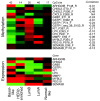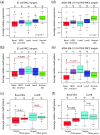Molecular subtypes of breast cancer are associated with characteristic DNA methylation patterns
- PMID: 20565864
- PMCID: PMC2917031
- DOI: 10.1186/bcr2590
Molecular subtypes of breast cancer are associated with characteristic DNA methylation patterns
Abstract
Introduction: Five different molecular subtypes of breast cancer have been identified through gene expression profiling. Each subtype has a characteristic expression pattern suggested to partly depend on cellular origin. We aimed to investigate whether the molecular subtypes also display distinct methylation profiles.
Methods: We analysed methylation status of 807 cancer-related genes in 189 fresh frozen primary breast tumours and four normal breast tissue samples using an array-based methylation assay.
Results: Unsupervised analysis revealed three groups of breast cancer with characteristic methylation patterns. The three groups were associated with the luminal A, luminal B and basal-like molecular subtypes of breast cancer, respectively, whereas cancers of the HER2-enriched and normal-like subtypes were distributed among the three groups. The methylation frequencies were significantly different between subtypes, with luminal B and basal-like tumours being most and least frequently methylated, respectively. Moreover, targets of the polycomb repressor complex in breast cancer and embryonic stem cells were more methylated in luminal B tumours than in other tumours. BRCA2-mutated tumours had a particularly high degree of methylation. Finally, by utilizing gene expression data, we observed that a large fraction of genes reported as having subtype-specific expression patterns might be regulated through methylation.
Conclusions: We have found that breast cancers of the basal-like, luminal A and luminal B molecular subtypes harbour specific methylation profiles. Our results suggest that methylation may play an important role in the development of breast cancers.
Figures







Similar articles
-
Genomic subtypes of breast cancer identified by array-comparative genomic hybridization display distinct molecular and clinical characteristics.Breast Cancer Res. 2010;12(3):R42. doi: 10.1186/bcr2596. Epub 2010 Jun 24. Breast Cancer Res. 2010. PMID: 20576095 Free PMC article.
-
Distinct patterns of promoter CpG island methylation of breast cancer subtypes are associated with stem cell phenotypes.Mod Pathol. 2012 Feb;25(2):185-96. doi: 10.1038/modpathol.2011.160. Epub 2011 Oct 28. Mod Pathol. 2012. PMID: 22037257
-
DNA methylome of familial breast cancer identifies distinct profiles defined by mutation status.Am J Hum Genet. 2010 Mar 12;86(3):420-33. doi: 10.1016/j.ajhg.2010.02.008. Epub 2010 Mar 4. Am J Hum Genet. 2010. PMID: 20206335 Free PMC article.
-
Nonfamilial breast cancer subtypes.Methods Mol Biol. 2013;973:279-95. doi: 10.1007/978-1-62703-281-0_18. Methods Mol Biol. 2013. PMID: 23412797 Review.
-
The cell of origin of BRCA1 mutation-associated breast cancer: a cautionary tale of gene expression profiling.J Mammary Gland Biol Neoplasia. 2011 Apr;16(1):51-5. doi: 10.1007/s10911-011-9202-8. Epub 2011 Feb 19. J Mammary Gland Biol Neoplasia. 2011. PMID: 21336547 Review.
Cited by
-
The epigenetic silencing of the estrogen receptor (ER) by hypermethylation of the ESR1 promoter is seen predominantly in triple-negative breast cancers in Indian women.Tumour Biol. 2012 Apr;33(2):315-23. doi: 10.1007/s13277-012-0343-1. Epub 2012 Feb 24. Tumour Biol. 2012. PMID: 22362381
-
Array-based DNA methylation profiling for breast cancer subtype discrimination.PLoS One. 2010 Sep 7;5(9):e12616. doi: 10.1371/journal.pone.0012616. PLoS One. 2010. PMID: 20830311 Free PMC article.
-
Loss of epigenetic suppression of retrotransposons with oncogenic potential in aging mammary luminal epithelial cells.Genome Res. 2023 Aug;33(8):1229-1241. doi: 10.1101/gr.277511.122. Epub 2023 Jul 18. Genome Res. 2023. PMID: 37463750 Free PMC article.
-
DNA Methylation Profiles and Their Diagnostic Utility in BC.Dis Markers. 2019 May 6;2019:6328503. doi: 10.1155/2019/6328503. eCollection 2019. Dis Markers. 2019. PMID: 31198475 Free PMC article.
-
DNA methylation profiling reveals a predominant immune component in breast cancers.EMBO Mol Med. 2011 Dec;3(12):726-41. doi: 10.1002/emmm.201100801. Epub 2011 Nov 16. EMBO Mol Med. 2011. PMID: 21910250 Free PMC article.
References
-
- Esteller M, Corn PG, Baylin SB, Herman JG. A gene hypermethylation profile of human cancer. Cancer Res. 2001;61:3225–3229. - PubMed
-
- Kondo Y, Shen L, Cheng AS, Ahmed S, Boumber Y, Charo C, Yamochi T, Urano T, Furukawa K, Kwabi-Addo B, Gold DL, Sekido Y, Huang TH, Issa JP. Gene silencing in cancer by histone H3 lysine 27 trimethylation independent of promoter DNA methylation. Nat Genet. 2008;40:741–750. doi: 10.1038/ng.159. - DOI - PubMed
Publication types
MeSH terms
Substances
LinkOut - more resources
Full Text Sources
Other Literature Sources
Medical
Molecular Biology Databases
Research Materials
Miscellaneous

